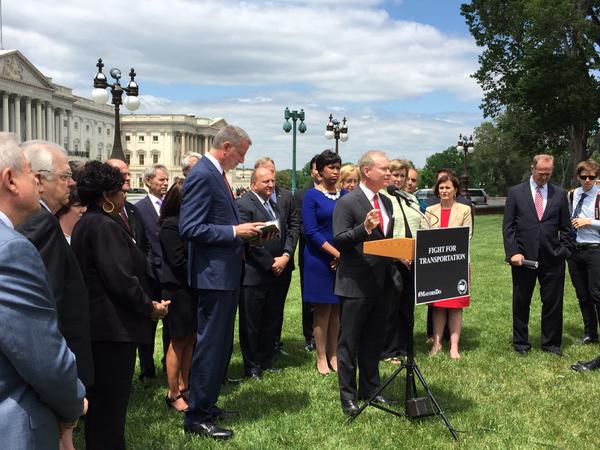
Local jurisdictions are paying the price for Congressional inaction.
Advocates and influencers from across the country are converging on Capitol Hill Wednesday for Infrastructure Advocacy Day, where they are urging lawmakers to fund long-term investment to rebuild and repair America’s aging infrastructure.
Big city mayors, small business owners, corporate executives, local and state legislators, union members and community leaders are among those meeting with Members of Congress and their staffs on Capitol Hill. Their message: Neglected infrastructure is hurting American communities, costing 900,000 good-paying jobs and making America less competitive on the global stage. America’s infrastructure now ranks 16th compared to our major trading partners.
#AAPA_Seaports with other industries to Hit the Hill, giving a hardhat to #RepEsty (CT) to #RebuildRenew pic.twitter.com/MijuvlP7mL
— susan monteverde (@susanmonteverde) May 13, 2015
.@wmata Planning chief on why Metrorail has led to jobs. DC would be unimaginable with it #RebuildRenew #eesitalk pic.twitter.com/AQasy9Zlbj
— Dennis Lytton (@DennisLytton) May 13, 2015
An honor to speak at presser on #transportation alongside @BilldeBlasio @MayorHodges #MayorsDo #rebuildrenew pic.twitter.com/H3Hkn7li9c
— Tomás Regalado (@Tomas_Regalado) May 13, 2015
Learning about #advocacy on #RebuildRenew from @ASCEGovRel #ascer92015flyin pic.twitter.com/IbbuqHO9J7
— Richard Markuson (@rhmcae) May 13, 2015
.@RepDavidRouzer dons #InfrastructureWeek hardhat during our visit to discuss #water & #transportation #RebuildRenew pic.twitter.com/e8mUDLojyb
— Susan Mays (@WaterMizz) May 13, 2015
Looming over Wednesday’s Hill activities is the tragic derailment of an Amtrak train in Philadelphia, which killed at least seven people and left more than 200 people hospitalized. The cause of the Tuesday night incident remains unclear, and Amtrak suspended service between Philadelphia and New York in the wake of the derailment.
The Northeast Corridor, where the derailment took place, is the most heavily traveled Amtrak route. More than 8 million riders on the Northeast Regional in 2012, along with 3.4 million additional riders taking the Acela Express that same year.
Before Tuesday’s derailment — and again, we don’t yet know the cause — advocates were calling for significant investment in America’s aging railway infrastructure. As National Journal reported in April, the House of Representatives recently agreed to fund Amtrak for the next four years at a rate of $1.4 billion per year (a House committee actually voted to cut that amount to $1.1 billion on Wednesday afternoon). China, meanwhile, is spending $128 billion on rail this year alone.
And Amtrak railways need significant repair. 60 Minutes recently chatted with Amtrak President and CEO Joe Boardman, who shared the story of the Portal Bridge, which carries 500 trains per day over the Hackensack River in New Jersey. Based on a design from the 1840s, the bridge was obsolete shortly after it opened in 1910. Boardman called it the “Achilles heel” of the Northeast Corridor.
But as the turnout on Capitol Hill today shows, it isn’t a lack of awareness that is preventing action. Prominent officials from both parties are actively sounding the alarm about infrastructure, including Transportation Secretary Anthony Foxx, former Transportation Secretary Ray LaHood and former Pennsylvania Gov. Ed Rendell. Vice President Joe Biden is perhaps the biggest cheerleader for infrastructure investment.
And just today, Democratic New York Mayor Bill de Blasio and Republican Oklahoma City Mayor Mick Cornett co-bylined an op-ed published in the New York Times explaining how ignoring our infrastructure is holding cities back — even though the demand for significant investment is there:
“Transit ridership is at record highs, with 10.8 billion trips in 2014. Meanwhile, in the 102 largest metropolitan regions, motorists take more than 200 million trips every day across deficient bridges. Freight volumes are expected to increase by 24 percent in the next seven years. Federal investment has not kept pace with this demand, resulting in an outdated, overburdened surface transportation system that is ill equipped to handle current, let alone future, need. Spending on infrastructure in the United States has sunk to 1.7 percent of gross domestic product, a 20-year low.”
So where do things stand on Capitol Hill?
The Highway Trust Fund, which provides funding for infrastructure projects, is set to expire at the end of the month. Congress is expected to pass a temporary fix to keep it going in the short-term until a long-term solution is reached.
By repeatedly kicking the can on infrastructure, Congress is leaving millions of good-paying jobs on the table. More than 2.5 million new jobs would be created by a long-term transportation bill worth $114 billion annually. Each $1 billion in infrastructure investment creates more than 21,000 new jobs.
“These kinds of infrastructure jobs create a virtuous cycle,” Biden noted on Monday. “First of all, they attract and retain business. Secondly — and these are good, middle-class paying jobs, you actually can raise a family on them — it creates and supports millions of jobs.”
And while we wait for real action from Capitol Hill, more than one in five U.S. bridges is considered structurally deficient, one in five roads is in poor condition, and our railways, airports, transit systems, pipelines and ports all continue to deteriorate.
